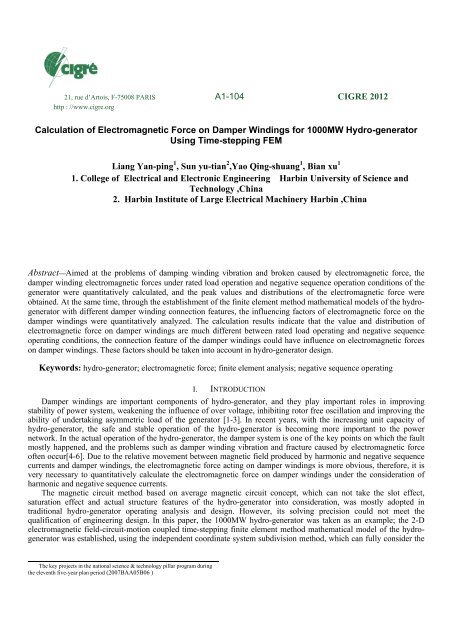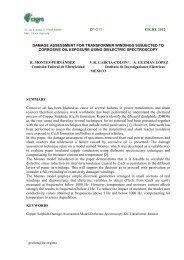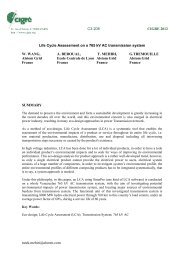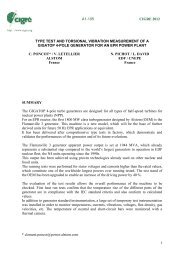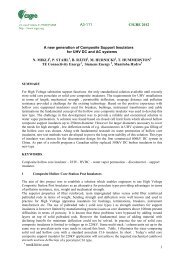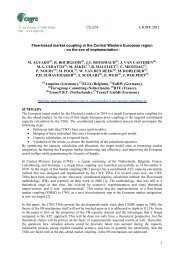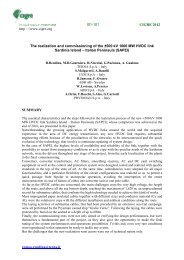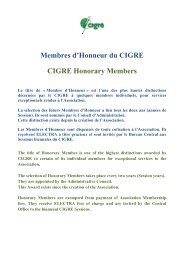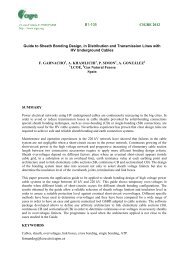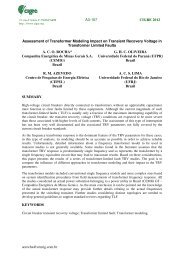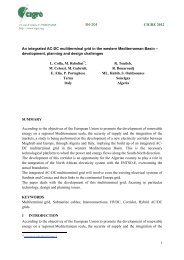A1-104 CIGRE 2012 Calculation of Electromagnetic Force on ...
A1-104 CIGRE 2012 Calculation of Electromagnetic Force on ...
A1-104 CIGRE 2012 Calculation of Electromagnetic Force on ...
Create successful ePaper yourself
Turn your PDF publications into a flip-book with our unique Google optimized e-Paper software.
)Eddy current in damping windingsFig.3 The magnetic field and eddy current in damping windingunder rated load operati<strong>on</strong>Based <strong>on</strong> the numerical calculati<strong>on</strong> <str<strong>on</strong>g>of</str<strong>on</strong>g> electromagnetic field and according to formula (2) to (4), theelectromagnetic force distributi<strong>on</strong> acting <strong>on</strong> damping windings was shown in Fig.4 when the generator was in the state<str<strong>on</strong>g>of</str<strong>on</strong>g> rated load operati<strong>on</strong>. Fig.4a) showed the electromagnetic force values <str<strong>on</strong>g>of</str<strong>on</strong>g> nine damping windings under the rated loadoperati<strong>on</strong>. Fig.4 b) showed the electromagnetic force status <str<strong>on</strong>g>of</str<strong>on</strong>g> the No.1 damping winding as the time changed in acycle.<str<strong>on</strong>g>Electromagnetic</str<strong>on</strong>g> force(N)100500-50-100FrFt-1500 2 4 6 8 10Damping winding numbera) <str<strong>on</strong>g>Electromagnetic</str<strong>on</strong>g> force values <str<strong>on</strong>g>of</str<strong>on</strong>g> all damping windings<str<strong>on</strong>g>Electromagnetic</str<strong>on</strong>g> force(N)150100500-50-100 FrFt-1500 5 10 15 20Time(ms)b) The electromagnetic force <str<strong>on</strong>g>of</str<strong>on</strong>g> the No.1 damping windingas time changesFig.4 The electromagnetic force distributi<strong>on</strong> acting <strong>on</strong> damping windings under rated running operati<strong>on</strong>From Fig.4 a), it could be seen that al<strong>on</strong>g the rotor rotati<strong>on</strong> directi<strong>on</strong> the electromagnetic force <str<strong>on</strong>g>of</str<strong>on</strong>g> the first dampingwinding (1 # damping winding) was significantly greater than the rest <str<strong>on</strong>g>of</str<strong>on</strong>g> the damping windings. Meanwhile, thetangential magnetic force <str<strong>on</strong>g>of</str<strong>on</strong>g> the No.1 damping winding was greater than the radial electromagnetic force <str<strong>on</strong>g>of</str<strong>on</strong>g> that. FromFig.4 b), it indicated that the electromagnetic force <str<strong>on</strong>g>of</str<strong>on</strong>g> the No.1 damping winding which suffered the largest forcewould fluctuate in a time period, because <str<strong>on</strong>g>of</str<strong>on</strong>g> the harm<strong>on</strong>ic current in damping winding.B. The Negative Sequence Operati<strong>on</strong> C<strong>on</strong>diti<strong>on</strong>The hydro-generator which can withstand the most severe c<strong>on</strong>diti<strong>on</strong>s <str<strong>on</strong>g>of</str<strong>on</strong>g> negative sequence is 12% negativesequence in China's regulati<strong>on</strong>. So this paper mainly studied the 12% negative chr<strong>on</strong>ological asymmetric operating
c<strong>on</strong>diti<strong>on</strong>s. Fig.5 showed the magnetic field distributi<strong>on</strong> when the generator was under 12% negative sequenceoperati<strong>on</strong>.a) T=40ms b) T=50msFig.5 The magnetic field distributi<strong>on</strong> under asymmetrical operati<strong>on</strong>Fig.5 showed that in a cycle <str<strong>on</strong>g>of</str<strong>on</strong>g> the asymmetrical operati<strong>on</strong>, the changes <str<strong>on</strong>g>of</str<strong>on</strong>g> the magnetic field distributi<strong>on</strong> inmagnetic pole were very intense. The magnetic field near number 1 changed frequently and the amplitude was bigger.The magnetic field and eddy current in damping winding were shown in Fig.6. It could be seen from the figurethat the No. 1 damping winding had the highest magnetic flow density and others were low. The eddy current density inthe No.9 damping windings had the highest value.a)Magnetic field in damping windingsb)Eddy current in damping windingsFig.6 The magnetic field and eddy current in damping windingunder negative sequence operati<strong>on</strong>Fig.7 was the electromagnetic force distributi<strong>on</strong> acting <strong>on</strong> damping windings. From Fig.7 a), it could be seen thatal<strong>on</strong>g the rotor rotati<strong>on</strong> directi<strong>on</strong> the electromagnetic force <str<strong>on</strong>g>of</str<strong>on</strong>g> the last damping winding (9 # damping winding) wassignificantly greater than the rest <str<strong>on</strong>g>of</str<strong>on</strong>g> the damping windings. Meanwhile, the radial magnetic force <str<strong>on</strong>g>of</str<strong>on</strong>g> the No.9 dampingwinding was greater than the tangential electromagnetic force <str<strong>on</strong>g>of</str<strong>on</strong>g> the No.9 damping winding. From Fig.7b), it indicatedthat the electromagnetic force <str<strong>on</strong>g>of</str<strong>on</strong>g> the No.9 damping winding, which suffered the largest force, would fluctuate in a timeperiod, because <str<strong>on</strong>g>of</str<strong>on</strong>g> the harm<strong>on</strong>ic current in damping winding.<str<strong>on</strong>g>Electromagnetic</str<strong>on</strong>g> force(N)10000-1000-2000FrFt-30000 2 4 6Damping winding number8 10a) <str<strong>on</strong>g>Electromagnetic</str<strong>on</strong>g> force values <str<strong>on</strong>g>of</str<strong>on</strong>g> all damping windings
<str<strong>on</strong>g>Electromagnetic</str<strong>on</strong>g> force(N)200010000-1000-2000FrFt-30000 5 10 15 20Time(ms)b) The electromagnetic force <str<strong>on</strong>g>of</str<strong>on</strong>g> No.9 damping winding as time changesFig.7 The electromagnetic force distributi<strong>on</strong> acting <strong>on</strong> damping windings under negative sequence operati<strong>on</strong>C. The Different Damper Winding C<strong>on</strong>necti<strong>on</strong> FeaturesHydro-generator rotor has damping system within the magnetic poles, and the damping system are composed <str<strong>on</strong>g>of</str<strong>on</strong>g>article damping, damping ring, damping ring joint piece and other parts. According to the joint form <str<strong>on</strong>g>of</str<strong>on</strong>g> damping ring,the damping system is divided into the damping system and half damping system. The c<strong>on</strong>necti<strong>on</strong> modes <str<strong>on</strong>g>of</str<strong>on</strong>g> circuit intwo different kinds <str<strong>on</strong>g>of</str<strong>on</strong>g> damping ring c<strong>on</strong>necti<strong>on</strong> forms are shown in Fig.8.a) The half damping systemb) The absolute damping systemFig.8 The c<strong>on</strong>necti<strong>on</strong> modes <str<strong>on</strong>g>of</str<strong>on</strong>g> circuit in two different kinds <str<strong>on</strong>g>of</str<strong>on</strong>g> damping ring c<strong>on</strong>necti<strong>on</strong> formsThe damping system is that the damping ring is fixed through the core tighten screw and the damping ringbetween adjacent poles is c<strong>on</strong>nected through the c<strong>on</strong>necting link. This structure design makes the parallel dampingbars within the individual pole c<strong>on</strong>nect with other damping bars in other poles together. The half damping system is
that when the damping ring is fixed in each pole, it will not c<strong>on</strong>nect with other damping rings in adjacent poles. Thisstructure design makes the damping bars in a pole <strong>on</strong>ly mutual parallel itself.The rated operati<strong>on</strong> and negative sequence operati<strong>on</strong> researched above mainly researched <strong>on</strong> the half dampingsystem. When the generator adopted the absolute damping system in negative sequence operati<strong>on</strong>, the calculati<strong>on</strong>results were as follows. The magnetic field and eddy current in damping winding <str<strong>on</strong>g>of</str<strong>on</strong>g> the absolute damping system wereshown in Fig.9.a)Magnetic field in damping windingsb)Eddy current in damping windingsFig.9 The magnetic field and eddy current in damping winding <str<strong>on</strong>g>of</str<strong>on</strong>g> the absolute damping systemIt could be seen from Fig.9 that the No.1 damping winding had the highest magnetic flow density and the otherswere less. The eddy current density in the No.1 damping winding was bigger than the others. Fig.10 showed theelectromagnetic force distributi<strong>on</strong> acting <strong>on</strong> damping windings.From Fig.10 a), it could be seen that al<strong>on</strong>g the rotor rotati<strong>on</strong> directi<strong>on</strong> the electromagnetic force <str<strong>on</strong>g>of</str<strong>on</strong>g> the first dampingwinding (1 # damping winding) was significantly greater than the rest <str<strong>on</strong>g>of</str<strong>on</strong>g> the damping windings. Meanwhile, thetangential magnetic force <str<strong>on</strong>g>of</str<strong>on</strong>g> the No.1 damping winding was greater than the radial electromagnetic force <str<strong>on</strong>g>of</str<strong>on</strong>g> the No.1damping winding. From Fig.10 b), it indicated that the electromagnetic force <str<strong>on</strong>g>of</str<strong>on</strong>g> the No.1 damping winding whichsuffered the largest force would fluctuate in a time period, because <str<strong>on</strong>g>of</str<strong>on</strong>g> the harm<strong>on</strong>ic current in damping winding. Theradial electromagnetic force and the tangential electromagnetic force played respective role at different time.2000<str<strong>on</strong>g>Electromagnetic</str<strong>on</strong>g> force(N)0-2000-4000FrFt-60000 2 4 6 8 10Damping winding numbera) The electromagnetic force <str<strong>on</strong>g>of</str<strong>on</strong>g> the No.1 damping winding<str<strong>on</strong>g>Electromagnetic</str<strong>on</strong>g> force(N)Fr0.5Ft0-0.5-10 5 10Time(ms)15 201 x <str<strong>on</strong>g>104</str<strong>on</strong>g>b) The electromagnetic force <str<strong>on</strong>g>of</str<strong>on</strong>g> the No.1 damping winding as time changes
Fig.10 The electromagnetic force distributi<strong>on</strong> acting <strong>on</strong> damping windings under negative sequence operati<strong>on</strong> <str<strong>on</strong>g>of</str<strong>on</strong>g>absolute damping systemIV. CONCLUSIONSThe mathematic model <str<strong>on</strong>g>of</str<strong>on</strong>g> electromagnetic force calculati<strong>on</strong> <str<strong>on</strong>g>of</str<strong>on</strong>g> damping system is established in this paper, whichcombined large hydro-generator with Lorentz force method. Taking the 1000MW large hydro-generator as an example,the electromagnetic force distributi<strong>on</strong> under rated operati<strong>on</strong> and negative sequence operati<strong>on</strong> c<strong>on</strong>diti<strong>on</strong> wererespectively analyzed. The c<strong>on</strong>clusi<strong>on</strong>s obtained were as follows:1) Al<strong>on</strong>g the rotati<strong>on</strong> directi<strong>on</strong> <str<strong>on</strong>g>of</str<strong>on</strong>g> the rotor, the electromagnetic force <str<strong>on</strong>g>of</str<strong>on</strong>g> the first damping winding (1 # dampingwinding) was significantly greater than the rest <str<strong>on</strong>g>of</str<strong>on</strong>g> the damping windings in rated operati<strong>on</strong> and the radialelectromagnetic force was greater than the tangential electromagnetic force.2) Al<strong>on</strong>g the rotati<strong>on</strong> directi<strong>on</strong> <str<strong>on</strong>g>of</str<strong>on</strong>g> the rotor, the electromagnetic force <str<strong>on</strong>g>of</str<strong>on</strong>g> the last damping winding (9 # dampingwinding) was significantly greater than the rest <str<strong>on</strong>g>of</str<strong>on</strong>g> the damping windings under negative sequence operati<strong>on</strong>.Meanwhile, the tangential magnetic force <str<strong>on</strong>g>of</str<strong>on</strong>g> the No.9 damping winding was greater than the radial electromagneticforce <str<strong>on</strong>g>of</str<strong>on</strong>g> the No.9 damping winding.3) When the absolute damping system was adopted, the electromagnetic force <str<strong>on</strong>g>of</str<strong>on</strong>g> the first damping winding (1 #damping winding) was significantly greater than the rest <str<strong>on</strong>g>of</str<strong>on</strong>g> the damping windings al<strong>on</strong>g the rotati<strong>on</strong> directi<strong>on</strong> <str<strong>on</strong>g>of</str<strong>on</strong>g> therotor. Meanwhile, the radial magnetic force <str<strong>on</strong>g>of</str<strong>on</strong>g> the No.1 damping winding was greater than the tangentialelectromagnetic force <str<strong>on</strong>g>of</str<strong>on</strong>g> the No.1 damping winding.4) Under the negative sequence operati<strong>on</strong> <str<strong>on</strong>g>of</str<strong>on</strong>g> the generator, the radial electromagnetic force played more importantrole than the tangential magnetic force. Under the rated load operati<strong>on</strong>, this otherness was inc<strong>on</strong>spicuous.REFERENCES[1] Li Shufang. Yao Ruoping, and Gao Yougang. “A new method to determine the 3-D field andtranspositi<strong>on</strong> way <str<strong>on</strong>g>of</str<strong>on</strong>g> large generator[C],” Power Engineering Society 1999 Winter Meeting, Vol.2 , No.1,pp.9-12, 1999.[2] Johann Hal demand. “Transpositi<strong>on</strong> in stator bars <str<strong>on</strong>g>of</str<strong>on</strong>g> large turbogenerators[J],” IEEE Transacti<strong>on</strong>s<strong>on</strong> <strong>on</strong>energy c<strong>on</strong>versi<strong>on</strong>, Vol.119, No.3, pp.553-560, 2004.[3] Nabeta S.I, Foggia A , Coulomb J-L , and Reyen,G . “A n<strong>on</strong>-linear time-stepped finite-elementsimulati<strong>on</strong> <str<strong>on</strong>g>of</str<strong>on</strong>g> a symmetricl short-circuit in a synchr<strong>on</strong>ous machine[J],” IEEE Trans <strong>on</strong> Magnetics,Vol.31, No.3, pp.2040-2043, 1995.[4] Sturgess J P,Zhu M,and Macd<strong>on</strong>ald D Cl.“Finite-element simulati<strong>on</strong><str<strong>on</strong>g>of</str<strong>on</strong>g> a generator <strong>on</strong> load duringand after a three-phase fault[J],” IEEE Trans <strong>on</strong> EC,Vol.7, No.4, pp.787-793, 1992.[5] Sun Yuguang, Wang Xiangheng, Gui Lin, and Wang Weijian. “Transient calculati<strong>on</strong> <str<strong>on</strong>g>of</str<strong>on</strong>g> stator’s internalfaults in synchr<strong>on</strong>ous generator using FEM coupled with multi-loop method[J],” Proceedings <str<strong>on</strong>g>of</str<strong>on</strong>g> theCSEE, Vol.24, No.1, pp.136-141, 2004. (in Chinese)[6] He Chenbing, Gu Yuji<strong>on</strong>g, and Xing Cheng. “Coupled flexural and torsi<strong>on</strong>al vibrati<strong>on</strong>s analysis <str<strong>on</strong>g>of</str<strong>on</strong>g>turbine generator shaft systems caused by short circuit fault[J],” Proceedings <str<strong>on</strong>g>of</str<strong>on</strong>g> the CSEE,Vol.30, No.32,pp.84-90, 2010. (in Chinese)[7] Men Liang , Luo Yingli , and Liu Xia<str<strong>on</strong>g>of</str<strong>on</strong>g>ang , Yang Jinfu,Chi Y<strong>on</strong>gbin . “A case study <str<strong>on</strong>g>of</str<strong>on</strong>g>electromagnetic force distributi<strong>on</strong> <strong>on</strong> rotor core surface <str<strong>on</strong>g>of</str<strong>on</strong>g> turbo generator[J],” Proceedings <str<strong>on</strong>g>of</str<strong>on</strong>g> theCSEE,Vol.25, No.1, pp.81-86, 2005 .(in Chinese)[8] Li Zhiqiang,Luo Yingli,and Meng Liang.“The calculati<strong>on</strong> <str<strong>on</strong>g>of</str<strong>on</strong>g> local magnetic force in turbogeneratorwith FEM based virtual work principle[J],” Proceedings <str<strong>on</strong>g>of</str<strong>on</strong>g> the CSEE, Vol.27, No.15, pp.47-52, 2006. (in Chinese)


